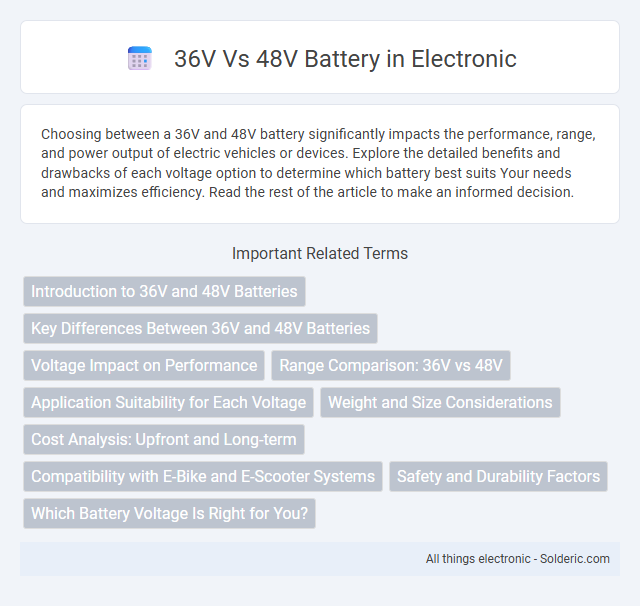Choosing between a 36V and 48V battery significantly impacts the performance, range, and power output of electric vehicles or devices. Explore the detailed benefits and drawbacks of each voltage option to determine which battery best suits Your needs and maximizes efficiency. Read the rest of the article to make an informed decision.
Comparison Table
| Feature | 36V Battery | 48V Battery |
|---|---|---|
| Voltage Output | 36 Volts | 48 Volts |
| Power Efficiency | Moderate | Higher |
| Top Speed | Lower max speed | Higher max speed |
| Range | Shorter range | Longer range |
| Charge Time | Typically faster | Typically slower |
| Weight | Lighter | Heavier |
| Cost | Lower price | Higher price |
| Application | Urban commuting, light usage | Off-road, heavy-duty, extended rides |
Introduction to 36V and 48V Batteries
36V and 48V batteries are commonly used in electric bicycles, scooters, and power tools, offering different voltage levels to match performance and range requirements. A 36V battery typically provides sufficient power for casual riding and moderate loads, while a 48V battery delivers higher voltage for increased speed, torque, and efficiency in demanding applications. Choosing between 36V and 48V depends on the specific device's motor compatibility, desired power output, and overall energy capacity.
Key Differences Between 36V and 48V Batteries
36V and 48V batteries differ primarily in voltage output, impacting power delivery and application suitability; 48V batteries provide higher power and efficiency, making them ideal for electric vehicles and high-performance e-bikes. The increased voltage of 48V systems allows for better torque and faster acceleration compared to 36V systems, which are often used in lighter applications or budget-friendly models. Battery weight and cost also vary, with 48V packs generally heavier and more expensive but offering extended range and improved overall performance.
Voltage Impact on Performance
A 48V battery delivers higher voltage, resulting in increased power output and improved acceleration compared to a 36V battery. This voltage difference enhances motor efficiency, allowing for better hill-climbing ability and overall speed performance. Choosing the right voltage can directly influence your electric vehicle's range and responsiveness.
Range Comparison: 36V vs 48V
A 48V battery typically offers a longer range compared to a 36V battery due to its higher voltage, which provides increased power output and efficiency for electric vehicles and bikes. This voltage boost allows the motor to draw more energy, enhancing overall performance and extending travel distance on a single charge. Range differences can vary, but 48V systems often deliver up to 20-30% more mileage, making them preferable for longer commutes and demanding terrains.
Application Suitability for Each Voltage
36V batteries are ideal for moderate power applications such as electric bikes, scooters, and light electric tools, providing a balance between weight and performance suitable for daily commuting and casual use. 48V batteries deliver higher voltage and are better suited for demanding applications like electric motorcycles, high-performance e-bikes, and larger electric vehicles, offering enhanced torque and longer range for more intensive rides. Choosing the right voltage depends on your specific power needs, range expectations, and the type of vehicle or device you intend to power.
Weight and Size Considerations
A 36V battery is generally lighter and more compact compared to a 48V battery, making it ideal for applications where reducing weight and optimizing size are crucial. The increased voltage in a 48V battery requires more cells, resulting in a bulkier and heavier unit that may affect portability and space constraints. Your choice between 36V and 48V batteries should factor in the balance between power needs and the importance of maintaining a lightweight, compact design.
Cost Analysis: Upfront and Long-term
A 36V battery typically offers a lower upfront cost, making it a budget-friendly option for entry-level electric bikes and scooters. In contrast, a 48V battery, while more expensive initially, provides greater energy efficiency and longer range, reducing the frequency of replacements and maintenance expenses over time. Your long-term savings can be substantial with a 48V battery due to improved performance and extended battery life.
Compatibility with E-Bike and E-Scooter Systems
36V batteries are widely compatible with most entry-level and mid-range e-bike and e-scooter systems, offering a balance between power and efficiency ideal for casual riders. 48V batteries provide greater voltage output, enhancing motor performance and speed, but may require specific controllers and components designed to handle higher voltage, limiting cross-compatibility. Your choice should consider the voltage rating specified by your e-bike or e-scooter manufacturer to ensure optimal compatibility and system reliability.
Safety and Durability Factors
A 36V battery typically offers enhanced safety due to lower voltage stress on internal components, reducing the risk of overheating and electrical faults. In contrast, 48V batteries provide higher power output but require robust thermal management and quality cell construction to ensure durability and mitigate potential safety hazards. Proper battery management systems (BMS) and sturdy casing materials are essential for maintaining long-term durability and preventing failures in both voltage configurations.
Which Battery Voltage Is Right for You?
Choosing between a 36V and 48V battery depends on your electric vehicle's power requirements and your desired performance. A 36V battery offers a balance of weight and efficiency, ideal for casual riders or shorter commutes, while a 48V battery provides higher power and longer range, suitable for more demanding terrain or extended use. Your decision should consider factors like speed, battery life, and the specific demands of your electric bike or scooter.
36V vs 48V battery Infographic

 solderic.com
solderic.com